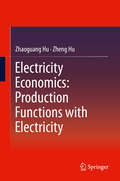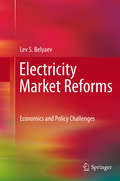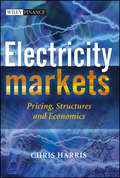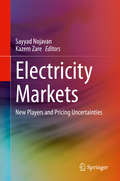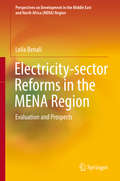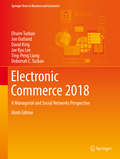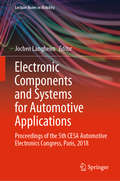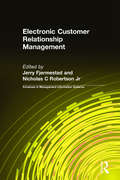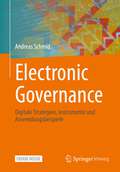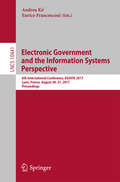- Table View
- List View
Electricity Economics: Production Functions with Electricity
by Zhaoguang Hu Zheng HuElectricity Economics: Production Functions with Electricity studies the production output from analyzing patterns of electricity consumption. Since electricity data can be used to measure scenarios of economic performance due to its accuracy and reliability, it could therefore also be used to help scholars explore new research frontiers that directly and indirectly benefits human society. Our research initially explores a similar pattern to substitute the Cobb-Douglas function with the production function with electricity to track and forecast economic activities. The book systematically introduces the theoretical frameworks and mathematical models of economics from the perspective of electricity consumption. The E-GDP functions are presented for case studies of more than 20 developed and developing countries. These functions also demonstrate substantial similarities between human DNA and production functions with electricity in terms of four major characteristics, namely replication, mutation, uniqueness, and evolution. Furthermore, the book includes extensive data and case studies on the U. S. , China, Japan, etc. It is intended for scientists, engineers, financial professionals, policy makers, consultants, and anyone else with a desire to study electricity economics as well as related applications. Dr. Zhaoguang Hu is the vice president and chief energy specialist at the State Grid Energy Research Institute, China. Zheng Hu is a PhD candidate at the Center for Energy and Environmental Policy, University of Delaware, USA.
Electricity Market Reforms
by Lev S. BelyaevWith the global demand for energy skyrocketing, over the past twenty years many countries have restructured their electric power industries, typically moving from a regulated monopoly to a competitive market structure. The results of these reforms vary significantly from country to country depending on the market organization model and national conditions. This book examines the restructuring in both developed and developing nations, with particular focus on the United States, Great Britain, China, and Russia, and addresses the problems arising from these transitions. The book also contains a comprehensive analysis of different electricity market models and their compatibility with the properties of electric power systems and country conditions. As the most thorough and up to date analysis of the theory and practical experience of electricity deregulation, this book is a must-read for academics, students and researchers with an interest in electric power industry restructuring. It also has direct relevance for engineers, regulators and other decision makers in companies and governmental agencies concerned with energy issues.
Electricity Markets
by Chris HarrisUnderstand the electricity market, its policies and how they drive prices, emissions, and security, with this comprehensive cross-disciplinary book. Author Chris Harris includes technical and quantitative arguments so you can confidently construct pricing models based on the various fluctuations that occur. Whether you?re a trader or an analyst, this book will enable you to make informed decisions about this volatile industry.
Electricity Markets with Increasing Levels of Renewable Generation: Structure, Operation, Agent-based Simulation, and Emerging Designs
by Fernando Lopes Helder CoelhoThis book describes the common ground between electricity markets (EMs) and software agents (or artificial intelligence generally). It presents an up-to-date introduction to EMs and intelligent agents, and offers a comprehensive description of the research advances and key achievements related to existing and emerging market designs to reliably and efficiently manage the potential challenges of variable generation (VG). Most EMs are unique in their complex relationships between economics and the physics of energy, but were created without the notion that large penetrations of variable generation (VG) would be part of the supply mix. An advanced multi-agent approach simulates the behavior of power markets over time, particularly markets with large-scale penetrations of renewable resources. It is intended as a reference book for researchers, academics and industry practitioners, but given the scope of the chapters and the highly accessible style, the book also provides a coherent foundation for several different graduate courses.
Electricity Markets: New Players and Pricing Uncertainties
by Sayyad Nojavan Kazem ZareThis book analyzes new electricity pricing models that consider uncertainties in the power market due to the changing behavior of market players and the implementation of renewable distributed generation and responsive loads. In-depth chapters examine the different types of market players including the generation, transmission, and distribution companies, virtual power plants, demand response aggregators, and energy hubs and microgrids. Expert authors propose optimal operational models for short-term performance and scheduling and present readers with solutions for pricing challenges in uncertain environments. This book is useful for engineers, researchers and students involved in integrating demand response programs into smart grids and for electricity market operation and planning.Proposes optimal operation models;Discusses the various players in today's electricity markets;Describes the effects of demand response programs in smart grids.
Electricity Restructuring in the United States
by Steve IsserThe electric utility industry in the US is technologically complex, and its structure as a classic network industry makes it intricate in business terms as well, so deregulation of such a complicated industry was a particularly detailed process. Steve Isser provides a detailed and comprehensive analysis of the history of the transformation of this complex industry from the 1978 Energy Policy Act to the present, covering the economic, legal, regulatory, and political issues and controversies in the transition from regulated utilities to competitive electricity markets. The book is a multidisciplinary study that includes a comprehensive review of the economic literature on electricity markets, the political environment of electricity policymaking, administrative and regulatory rulemaking, and the federal case law that restrained state and federal regulation of electricity. Dr Isser offers a valuable case study of the pitfalls and problems associated with the deregulation of a complex network industry.
Electricity Supply Systems of the Future (CIGRE Green Books)
by Nikos Hatziargyriou Iony Patriota de SiqueiraThis book offers a vision of the future of electricity supply systems and CIGRE’s views on the know-how that will be needed to manage the transition toward them. A variety of factors are driving a transition of electricity supply systems to new supply models, in particular the increasing use of renewable sources, environmental factors and developments in ICT technologies. These factors suggest that there are two possible models for power network development, and that those models are not necessarily exclusive: 1. An increasing importance of large networks for bulk transmission capable of interconnecting load regions and large centralized renewable generation resources, including offshore and of providing more interconnections between the various countries and energy markets. 2. An emergence of clusters of small, largely self-contained distribution networks, which include decentralized local generation, energy storage and active customer participation, intelligently managed so that they operate as active networks providing local active and reactive support. The electricity supply systems of the future will likely include a combination of the above two models, since additional bulk connections and active distribution networks are needed in order to reach ambitious environmental, economic and security-reliability targets. This concise yet comprehensive reference resource on technological developments for future electrical systems has been written and reviewed by experts and the Chairs of the sixteen Study Committees that form the Technical Council of CIGRE.
Electricity-sector Reforms in the MENA Region: Evaluation and Prospects (Perspectives on Development in the Middle East and North Africa (MENA) Region)
by Leila BenaliThis book uses electricity-sector reforms to question some of the preconceived ideas concerning the MENA region and to provide a broader analysis of related political economy issues. It presents potential further developments of MENA’s electricity-sector reforms, taking into consideration the region’s unique constraints and opportunities, and discusses the practical limits of reform and deregulation. Specifically, it examines the relationship between reforms and oil prices from a new perspective and presents alternatives to the Single Buyer Model. Complementing existing research on electricity-sector reforms in other emerging markets, the book provides a new analytical framework for assessing reforms that can be easily applied to other markets and sectors.
Electrifying Europe: The power of Europe in the construction of electricity networks (Technology and European History Series)
by Vincent LagendijkNowadays most consumers are aware of the European dimensions of their electricity supply. But what ideas lie behind this European network? In constructing electricity networks, “Europe” performed a Janus-faced function. On the one hand, a European network would bolster economic growth and peace. On the other, economic growth through electrification would increase military potential.By combining a wide array of rarely used sources, this book unravels how engineers, industrialists, and policymakers used ideas of Europe to gain support for building a European system. By focusing on transnational and European actors, this book is a valuable addition to existing national histories of electrification. It is an original contribution to the history of technology, while also making the role of technology visible in more mainstream European history.,The empirical chapters show how ideas of European cooperation in general became intertwined with network planning during the Interwar period, although the Depression and WWII prevented a European electricity network from being constructed. The subsequent chapters describe the influence of the Marshall Plan on European network-building, focusing on both its economic and military aspects. The last chapter portrays how the Iron Curtain was contested. The troubled expansion of networks and capacity in Western Europe provided an underpinning for political rapprochement with the East in the 1970s and 1980s. Political and economic turmoil after 1989 accelerated this process, leading to an interconnected European system by 1995.
Electrifying India: Regional Political Economies of Development
by Sunila S. KaleThroughout the 20th century, electricity was considered to be the primary vehicle of modernity, as well as its quintessential symbol. In India, electrification was central to how early nationalists and planners conceptualized Indian development, and huge sums were spent on the project from then until now. Yet despite all this, sixty-five years after independence nearly 400 million Indians have no access to electricity. Electrifying India explores the political and historical puzzle of uneven development in India's vital electricity sector. In some states, nearly all citizens have access to electricity, while in others fewer than half of households have reliable electricity. To help explain this variation, this book offers both a regional and a historical perspective on the politics of electrification of India as it unfolded in New Delhi and three Indian states: Maharashtra, Odisha, and Andhra Pradesh. In those parts of the countryside that were successfully electrified in the decades after independence, the gains were due to neither nationalist idealism nor merely technocratic plans, but rather to the rising political influence and pressure of rural constituencies. In looking at variation in how public utilities expanded over a long period of time, this book argues that the earlier period of an advancing state apparatus from the 1950s to the 1980s conditioned in important ways the manner of the state's retreat during market reforms from the 1990s onward.
Electrokinetics Across Disciplines and Continents
by Alexandra B. Ribeiro Eduardo P. Mateus Nazaré CoutoThe socio-economic activities due to world development are promoting increasing pressures on land, creating competition and conflicts, resulting in suboptimal use of resources. Integrated planning and management of land resources is a top subject of Agenda 21 (managed by FAO), which deals with the cross-sectoral aspects of decision-making for the sustainable use and development of natural resources. This is essential for life-support systems and its productive capacity. In this context, there is a need to find new strategies for sustainable development that links social and economic progress with environmental protection and enhancement. Electrokinetic transport processes (EK) uses a low-level direct current as the "cleaning agent". EK has been applied to the remediation of polluted soils and other contaminated matrices. It also shows a great potential to be used in different fields, as in saline soil restoration, nutrients recovery from wastes or repair and maintenance of building structures. EK may be an integrated approach for new strategies aiming at sustainable development and to support waste strategies, with worldwide interest. EK can also be coupled with phytoremediation and integrated with nanotechnology, enlarging the scope of its application. The conciliation of the EK in the recovery of secondary resources, remediation and conservation is a multidisciplinary novel approach that opens new technical possibilities for waste minimization, through upgrading of particulate waste products and the recovery of secondary resources for industrial, agricultural or social use.
Electronic Arts Introduces The Sims Online
by Youngme MoonElectronic Arts (EA), the world's largest independent game publisher, is preparing to launch an online, subscription-based version of the most popular PC game in history: The Sims. The new game is called "The Sims Online" and it differs from the original game in two key respects: the gaming experience and the payment structure. In this context, EA managers must finalize several decisions that they believe are fundamental to the game's success, including target market selection and pricing/payment structure.
Electronic Arts in Online Gaming
by Thomas R. Eisenmann Justin WongElectronic Arts (EA), the world's largest independent video-game publisher, must decide whether to support Microsoft's initiatives in online gaming. Historically, EA has been platform-agnostic, releasing versions of its titles for all major console platforms. However, its managers have serious concerns about Microsoft's strategy for its online gaming service, Xbox Live. Microsoft has maintained tight control over game features and customer relationships and has refused to share online gaming subscription revenues with game publishers. Sony has offered terms for Playstation2 online games that are acceptable to EA. Can EA afford to forfeit sales through Microsoft's platform?
Electronic Arts: The Blockbuster Strategy
by Michael A. Roberto Gina M. CarioggiaDescribes the process that the firm employs to allocate resources to new product development projects. Examines whether the firm can sustain its competitive advantage given its existing game design process.
Electronic Bill Presentment and Payment
by Kornel TerplanElectronic bill presentment and payment (EBPP) is revolutionizing the billing process by offering online and real time presentment of bill content and payment choices. EBPP is the easy way of viewing billing status, remittance items, and presenting balances using a universal browser from any location. In contrast to paper-based bills, electronic bi
Electronic Commerce
by Gary P. SchneiderPacked with real-world examples and business cases, ELECTRONIC COMMERCE, 11E continues to lead the market with its cutting-edge coverage of all things e-commerce. Comprehensive coverage of emerging online business strategies, up-to-the-minute technologies, and the latest developments from the field equips readers with a solid understanding of the dynamics of this fast-paced industry. The new edition offers thorough discussions of e-commerce growth in China and the developing world, social media and online marketing strategies, technology-enabled outsourcing, online payment processing systems, and much more. In addition, "Business Case Approaches" and "Learning From Failure" boxes highlight the experiences of actual companies to illustrate real-world practice in action.
Electronic Commerce 2018
by David King Efraim Turban Jae Kyu Lee Ting-Peng Liang Deborrah C. Turban Jon OutlandThis new Edition of Electronic Commerce is a complete update of the leading graduate level/advanced undergraduate level textbook on the subject. Electronic commerce (EC) describes the manner in which transactions take place over electronic networks, mostly the Internet. It is the process of electronically buying and selling goods, services, and information. Certain EC applications, such as buying and selling stocks and airline tickets online, are reaching maturity, some even exceeding non-Internet trades. However, EC is not just about buying and selling; it also is about electronically communicating, collaborating, and discovering information. It is about e-learning, e-government, social networks, and much more. EC is having an impact on a significant portion of the world, affecting businesses, professions, trade, and of course, people. The most important developments in EC since 2014 are the continuous phenomenal growth of social networks, especially Facebook , LinkedIn and Instagram, and the trend toward conducting EC with mobile devices. Other major developments are the expansion of EC globally, especially in China where you can find the world's largest EC company. Much attention is lately being given to smart commerce and the use of AI-based analytics and big data to enhance the field. Finally, some emerging EC business models are changing industries (e. g. , the shared economy models of Uber and Airbnb). The 2018 (9th) edition, brings forth the latest trends in e-commerce, including smart commerce, social commerce, social collaboration, shared economy, innovations, and mobility.
Electronic Commerce and International Private Law: A Study of Electronic Consumer Contracts (Markets And The Law Ser.)
by Lorna E. GilliesElectronic Commerce and International Private Law examines the maximization of consumer protection via the consumer's jurisdiction and law. It discusses the proposition that a new connecting factor be used to improve the efficiency of juridical protection for consumers who contract with foreign sellers by electronic means and offers recommendations as to how to amend existing jurisdiction and choice of law rules to provide a basis for the consumer to sue in his own jurisdiction and for the law of the consumer's domicile to apply. The book will be a valuable resource for academics, students and practitioners working in the areas of international private law, electronic commerce law and consumer law.
Electronic Communications for the Home and Office
by Ronald G. AlbrightThe book contains everything new online communicator would want or need. You‘ll find enough technical information on how everything works, but not more than you want to know. You‘ll find hands-on tips on what to look for in communications software. And you‘ll find action-provoking information on electronic and voice mnai9l, sending facsimiles without a fax machine, electronic data interchange, and how to quickly get your hands on hard-core, industrial strength information such has online services as DIALOG, BRS, Orbit, and The Knowledge Index.
Electronic Components and Systems for Automotive Applications: Proceedings of the 5th CESA Automotive Electronics Congress, Paris, 2018 (Lecture Notes in Mobility)
by Jochen LangheimThis volume collects selected papers of the 5th CESA Automotive Electronics Congress, Paris, 2018. CESA is the most important automotive electronics conference in France. The topical focus lies on state-of-the-art automotive electronics with respect to energy consumption and autonomous driving. The target audience primarily comprises industry leaders and research experts in the automotive industry.
Electronic Customer Relationship Management (Advances In Management Information Systems Ser.)
by Jerry Fjermestad Nicholas C Robertson JrThis work offers a state-of-the art survey of information systems research on electronic customer relationship management (eCRM). It provides important new frameworks derived from current cases and applications in this emerging field. Each chapter takes a collaborative approach to eCRM that goes beyond the analytical and operational perspectives most often taken by researchers in the field. Chapters also stress integration with other enterprise information systems. The book is organized in four parts: Part I presents an overview of the role of CRM and eCRM in marketing and supply chain management; Part II focuses on the organizational success factors behind eCRM implementation; Part III presents cases of eCRM performance enhancement; and Part IV addresses eCRM issues in business-to-consumer commerce.
Electronic Governance and Open Society: 5th International Conference, EGOSE 2018, St. Petersburg, Russia, November 14-16, 2018, Revised Selected Papers (Communications in Computer and Information Science #947)
by Dmitrii Trutnev Evgeny Roshchin Andrei Chugunov Yuri MisnikovThis book constitutes the refereed proceedings of the 5th Conference on AElectronic Governance and Open Society: Challenges in Eurasia, EGOSE 2018, held in St. Petersburg, Russia, in November 2018. The 36 revised full papers were carefully reviewed and selected from 98 submissions. The papers are organized in topical sections on smart city infrastructure, policy; digital privacy, rights,security;data science, machine learning, algorithms, computational linguistics; digital public administration, economy, policy; digital services, values, inclusion; digital democracy, participation, security, communities, social media, activism; social media discourse analysis; digital data, policy modeling; digital government, administration, communication.
Electronic Governance: Digitale Strategien, Instrumente und Anwendungsbeispiele
by Andreas SchmidNoch nie sind die technologischen Entwicklungen und die Veränderungen der Märkte so rasant verlaufen wie heutzutage. Die Digitalisierung von Wirtschaft und Gesellschaft stehen dabei erst am Anfang. Viele Menschen beobachten die Entwicklungen misstrauisch. Sie können mit den in Verbindung stehenden Methoden und Begriffen kaum etwas anfangen. Dieses Buch schafft Abhilfe, in dem es umfassend und verständlich aufklärt und erklärt. Beispiele aus Theorie und Praxis veranschaulichen die Inhalte. Die Beherrschung der zugehörigen Komplexitäten ist noch nicht gelungen, wie z.B. die lange Liste gescheiterter Digitalisierungsvorhaben anschaulich belegt. Es geht darum, die Unternehmen zukunftsfest zu machen und die Beschäftigten zu befähigen. Hierfür braucht es einer Art digitaler bzw. technisierter „Leitplanken“, die mit einer „Electronic Governance“ entwickelt und spezifiziert werden. Es handelt sich um ein Steuerungs- und Regelungssystem, welches Organisationen und ihre Beschäftigten in Zeiten der Digitalisierung erfolgreich in die Zukunft führt.
Electronic Government and the Information Systems Perspective: 5th International Conference, EGOVIS 2016, Porto, Portugal, September 5-8, 2016, Proceedings (Lecture Notes in Computer Science #9831)
by Enrico Francesconi Andrea KőThis book constitutes the refereed proceedings of the 5th International Conference on Electronic Government and the Information Systems Perspective, EGOVIS 2016, held in Porto, Portugal, in September 2016, in conjunction with DEXA 2015. The 22 revised full papers presented together with three invited talk were carefully reviewed and selected from 27 submissions. The papers are organized in the following topical sections: e-government cases - legal issues; e-government cases - technical issues; open data and transparency; knowledge representation and modeling in e-government; intelligent systems in e-government; e-government research and intelligent systems; e-government data and knowledge management; identity management in e-government.
Electronic Government and the Information Systems Perspective: 6th International Conference, EGOVIS 2017, Lyon, France, August 28-31, 2017, Proceedings (Lecture Notes in Computer Science #10441)
by Enrico Francesconi Andrea KőThis book constitutes the refereed proceedings of the 6th International Conference on Electronic Government and the Information Systems Perspective, EGOVIS 2017, held in Lyon, France, in August 2017. The 20 revised full papers presented were carefully reviewed and selected from 24 submissions. The papers areorganized in the following topical sections: digitalization and transparency; open data ecosystems; intelligent systems in e-government; e-government research and intelligent systems; m-government and inclusion; e-government cases - data knowledge management; and knowledge management in the context of e-government.
